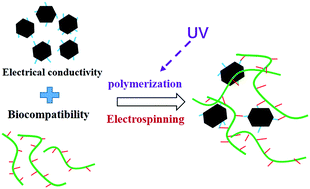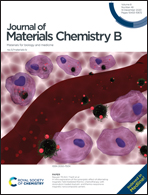Reduced graphene oxide–GelMA–PCL hybrid nanofibers for peripheral nerve regeneration†
Abstract
Graphene oxide is currently used in peripheral nerve engineering but has certain limitations, such as cytotoxicity and lack of electrical conductivity, both of which are crucial in regulating nerve-associated cell behaviors. In this work, we engineered reduced graphene oxide–GelMA–PCL nanofiber nerve guidance conduits via electrospinning. rGO incorporated into the GelMA/PCL matrix significantly enhanced the electrical conductivity and biocompatibility of the hybrid materials. In addition, hybrid nanofibers with low concentrations of rGO (0.25 and 0.5 wt%) could significantly improve the proliferation of Schwann cells (RSC96). More importantly, rGO/GelMA/PCL hybrid nanofibers could activate the epithelial–mesenchymal transition (EMT)-related gene expression of Schwann cells (RSC96). From the in vivo study, it was observed that rGO/GelMA/PCL nerve guidance conduits could promote both sensory/motor nerve regeneration and functional recovery in rats. Our composite strategy of combining rGO within a biocompatible nanofiber scaffold is simple but effective in improving tissue engineering outcomes. The rGO/GelMA/PCL hybrid nanofibers have great potential in peripheral nerve tissue engineering. They will also provide an experimental basis for the development of further electrical stimulation in peripheral nerve regeneration.

- This article is part of the themed collection: Editor’s Choice: Tissue Engineering


 Please wait while we load your content...
Please wait while we load your content...